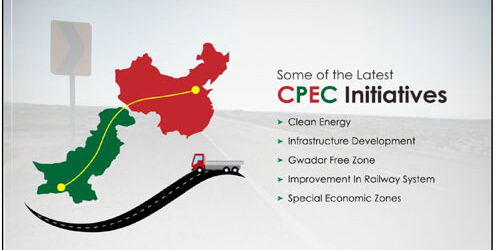THE China-Pakistan Economic Corridor (CPEC) is being jointly constructed by Pakistan and China with the Chinese investment of US $ 62 billion.
The project comprises a network of energy-producing plants, roads, railways, air/dry ports, fiber optic lines for communications, industrial zones, and agricultural modernization programs, being built in Pakistan to connect the Kashgar city of China with the Gwadar Port of Pakistan.
The CPEC will interconnect China, Central Asian Republics (CARs), Russia, South Asia, the Middle East, and North Africa through the warm waters of the Arabian Sea for facilitating trade, investment, tourism, and the exchange of labor.
The CPEC will cut short Beijing’s trade routes with the world through sea approximately by 12,000 miles.
The CPEC will enable the people of this region and other regions to harvest common benefits, kill poverty, and bring prosperity, within the context of Chinese President, Xi Jinping’s concept of the shared destinies, by building strong roots to take economic growth to the next level in the two countries and across the regions. The CPEC will also help in preserving peace at the regional and global levels.
The project is to be completed in three phases, Phase-1 by 2020, Phase-II by 2015, and Phase-III by 2030.
While Phase-I is meant to address the key economic bottlenecks namely energy and infrastructure, and Phase-II is about industrialization, socio-economic and agricultural cooperation, and promoting business.
Phase-III includes long-term projects, like the laying of a network of pipelines to transport liquefied natural gas and oil, including a $2.5 billion pipeline between Gwadar and Nawabshah to eventually transport gas from Iran.
In Phase-III, the government also plans to add new sectors, including iron, mines and minerals, oil and gas sector, copper, textiles, and automobile sectors to exploit the potential of trade through CPEC. China is ready to invest $10 billion in the oil and gas sector and $4 billion in the local steel sector through CPEC projects.
In Phase-1, a total of 1544 KM roads have been constructed and 1456 KM is under construction.
In the energy sector, 5320 MW of electricity has been added to the national grid, while work on seven projects with 4170 MW power projects is nearing completion. Additional projects of 2844 MW are planned.
Also, 820 km long cross border optical fiber laying projects, linking Khunjerab to Rawalpindi have been completed.
In Gwadar, 10 projects in infrastructure and social sector development have either been completed or are under construction.
The Gwadar port is functional. Most importantly, the Gwadar Smart Port City Master Plan for the integrated development of the city has been approved by the government and is ready for implementation.
The New Gwadar International Airport’s groundbreaking ceremony has already been held.
Currently, the focus is on industrialization, socio-economic development, agriculture modernization, blue economy, tourism promotion, and upgrading of the Railway Line from Karachi to Peshawar (MLI project).
The development of three special SEZs, namely; Rashakai, M3 Faisalabad, and Dhabeji Thatta is being done on a priority basis.
In view of the foregoing, it is not only important to stick to the schedule of the completion of the CPEC, rather there is a need to fast track its development to bring its benefits to Pakistan and its people, which is necessary for the country’s quick economic revival and alleviation of poverty. The fast-tracking of the development of the CPEC will accrue the following specific benefits.
The completed energy projects have already helped meet the power shortage in the country, to a large extent, by reducing the duration of load-shedding and enhancing industrial and agriculture production, and also increased the working hours of the services sector.
As a result, the country’s productivity and exports have considerably increased, thus raising its forex reserves from USD 16.7 billion in August 2018 to USD 23.2 billion in May 2021.
As per the CPEC Authority website, the annual revenue from toll collection from the CPEC is projected to be around $5 billion by 2022, which would ease the balance of payment issues and help in paying off the debt to China.
While the CPEC will create 2.3 million jobs between 2015 and 2030 for the Pakistanis, it will also raise Pakistan’s annual economic growth (GDP) by about 2 to 2.5 percent.
By 2025, the CPEC served industrial, agriculture, and services sectors would be working efficiently to enhance Pakistan’s economic growth, create many employment opportunities for its people to kill poverty, and bring prosperity.
By 2030, with the completion of the CPEC projects, its full potential will be used to achieve sustainable economic growth in Pakistan and the neighboring regions for the benefit of their people.
Finally, the CPEC supported boost in exports and forex reserves on a sustainable basis shall also help Pakistan in paying back its foreign loans, further strengthening its conventional defense capabilities and raising its strategic importance at the regional and world levels.






